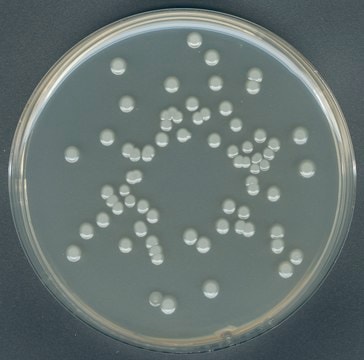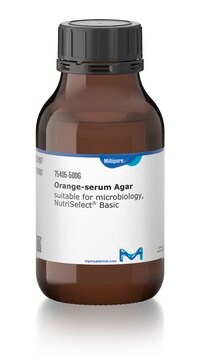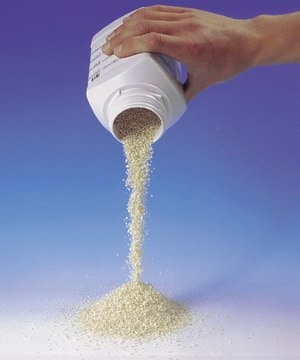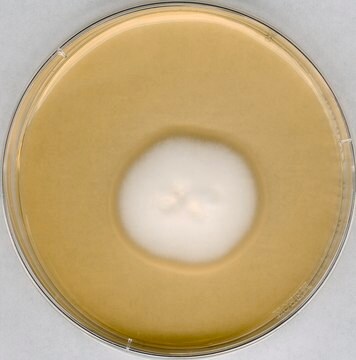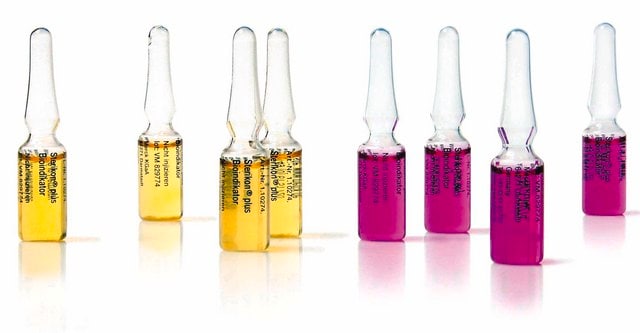추천 제품
Agency
according to IFU
Quality Level
양식
medium granules (dehydrated (DCM))
포장
pkg of 500 g
제조업체/상표
GranuCult®
저장 조건
protect from light (Keep tightly closed and dry)
기술
microbiological culture: suitable
색상
beige
pH
5.4-5.6 (37 °C, 42 g/L in H2O, after autoclaving)
solubility
42 g/L
벌크 밀도
700 kg/m3
응용 분야
food and beverages
microbiology
저장 온도
15-25°C
적합성
molds
yeasts
일반 설명
Orange Serum Agar is developed specifically to isolate and enumerate the microorganisms that can spoil citrus fruit beverages. Due to its low pH, citrus fruit juices are susceptible to spoilage, mainly by molds, yeasts, and acidophilic bacteria such as Lactobacillus and Leuconostoc. Orange Serum Agar is recommended by APHA for the examination of fruit beverages. Casein peptone and yeast extract provide essential nitrogenous and carbonaceous nutrients and vitamin B complex. Glucose is added as a carbon and energy source. Orange extract generates an optimal environment for the enrichment of acid-tolerant microorganisms from citrus fruit samples. Dipotassium hydrogen phosphate acts as buffering substance.
애플리케이션
Orange Serum agar is suitable for the isolation, cultivation, and enumeration of acid-tolerant spoilage microorganisms in fruit juice and fruit juice concentrates from citrus fruit.
특징 및 장점
- GranuCult® offers superior granulated culture media
- Safe and sustainable due to reduced risks associated with fine dust and toxic substance inhalation, resulting in a safer work environment
- Excellent wettability, solubility, and free-flowing properties
- Convenient, with minimal component separation and clumping, even under warm or humid conditions
- High batch-to-batch reproducibility
- Prolonged shelf life of up to five years
- High number of test strains exceeding all regulatory demands
- Granulation technology allows many supplements to be included, with no need to add these separately
분석 메모
Appearance (clearness): clear to opalescent
Appearance (color): yellowish to yellowish-brown
pH-value (25 °C): 5.4 - 5.6
Growth promotion test in accordance with the current version of DIN EN ISO 11133.
Inoculum on reference medium (Bacillus cereus ATCC 11778 (WDCM 00001)):
Inoculum on reference medium(Lactobacillus plantarum ATCC 14917 (WDCM 00104)):
Inoculum on reference medium (Lactobacillus casei ATCC 393 (WDCM 00100)):
Inoculum on reference medium(Leuconostoc mesenteroides ATCC 9135 (WDCM 00108)):
Inoculum on reference medium (Candida albicans ATCC 10231 (WDCM 00054)):
Colony count (Bacillus cereus ATCC 11778 (WDCM 00001)):
Colony count (Lactobacillus plantarum ATCC 14917 (WDCM 00104)):
Colony count (Lactobacillus casei ATCC 393 (WDCM 00100)):
Colony count (Leuconostoc mesenteroides ATCC 9135 (WDCM 00108)):
Colony count (Candida albicans ATCC 10231 (WDCM 00054)):
Recovery on test medium (Bacillus cereus ATCC 11778 (WDCM 00001)): ≥ 70 %
Recovery on test medium (Lactobacillus plantarum ATCC 14917 (WDCM 00104)): ≥ 70 %
Recovery on test medium (Lactobacillus casei ATCC 393 (WDCM 00100)): ≥ 70 %
Recovery on test medium (Leuconostoc mesenteroides ATCC 9135 (WDCM 00108)): ≥ 70 %
Recovery on test medium (Candida albicans ATCC 10231 (WDCM 00054)): ≥ 70 %
Growth (Aspergillus brasiliensis (formerly A. niger) ATCC 16404 (WDCM 00053)): good to very good
Incubation: 4 days at 26 ± 2 °C, aerobic
A recovery rate of 70 % is equivalent to a productivity value of 0.7.
The indicated colony counts result from the sum of a triple determination.
Reference media: Tryptic Soy Agar resp. SABOURAUD agar
Appearance (color): yellowish to yellowish-brown
pH-value (25 °C): 5.4 - 5.6
Growth promotion test in accordance with the current version of DIN EN ISO 11133.
Inoculum on reference medium (Bacillus cereus ATCC 11778 (WDCM 00001)):
Inoculum on reference medium(Lactobacillus plantarum ATCC 14917 (WDCM 00104)):
Inoculum on reference medium (Lactobacillus casei ATCC 393 (WDCM 00100)):
Inoculum on reference medium(Leuconostoc mesenteroides ATCC 9135 (WDCM 00108)):
Inoculum on reference medium (Candida albicans ATCC 10231 (WDCM 00054)):
Colony count (Bacillus cereus ATCC 11778 (WDCM 00001)):
Colony count (Lactobacillus plantarum ATCC 14917 (WDCM 00104)):
Colony count (Lactobacillus casei ATCC 393 (WDCM 00100)):
Colony count (Leuconostoc mesenteroides ATCC 9135 (WDCM 00108)):
Colony count (Candida albicans ATCC 10231 (WDCM 00054)):
Recovery on test medium (Bacillus cereus ATCC 11778 (WDCM 00001)): ≥ 70 %
Recovery on test medium (Lactobacillus plantarum ATCC 14917 (WDCM 00104)): ≥ 70 %
Recovery on test medium (Lactobacillus casei ATCC 393 (WDCM 00100)): ≥ 70 %
Recovery on test medium (Leuconostoc mesenteroides ATCC 9135 (WDCM 00108)): ≥ 70 %
Recovery on test medium (Candida albicans ATCC 10231 (WDCM 00054)): ≥ 70 %
Growth (Aspergillus brasiliensis (formerly A. niger) ATCC 16404 (WDCM 00053)): good to very good
Incubation: 4 days at 26 ± 2 °C, aerobic
A recovery rate of 70 % is equivalent to a productivity value of 0.7.
The indicated colony counts result from the sum of a triple determination.
Reference media: Tryptic Soy Agar resp. SABOURAUD agar
법적 정보
GRANUCULT is a registered trademark of Merck KGaA, Darmstadt, Germany
NutriSelect is a registered trademark of Merck KGaA, Darmstadt, Germany
면책조항
We offer two media types: the superior granulated GranuCult® and the cost-efficient powdered NutriSelect® culture media, depending on your needs. The designations basic, plus, or prime are added to indicate the quality control level, from basic quality control to standard QC plus to prime for full regulatory compliance.
Storage Class Code
11 - Combustible Solids
WGK
WGK 3
시험 성적서(COA)
제품의 로트/배치 번호를 입력하여 시험 성적서(COA)을 검색하십시오. 로트 및 배치 번호는 제품 라벨에 있는 ‘로트’ 또는 ‘배치’라는 용어 뒤에서 찾을 수 있습니다.
자사의 과학자팀은 생명 과학, 재료 과학, 화학 합성, 크로마토그래피, 분석 및 기타 많은 영역을 포함한 모든 과학 분야에 경험이 있습니다..
고객지원팀으로 연락바랍니다.